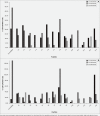Cellular immune responses induced in vitro by Ehrlichia ruminantium secreted proteins and identification of vaccine candidate peptides
- PMID: 27608502
- PMCID: PMC6238801
- DOI: 10.4102/ojvr.v83i1.1170
Cellular immune responses induced in vitro by Ehrlichia ruminantium secreted proteins and identification of vaccine candidate peptides
Abstract
Secreted proteins are reported to induce cell-mediated immunity characterised by the production of interferon-gamma (IFN)-γ. In this study three open reading frames (ORFs) (Erum8060, Erum7760, Erum5000) encoding secreted proteins were selected from the Ehrlichia ruminantium (Welgevonden) genome sequence using bioinformatics tools to determine whether they induce a cellular immune response in vitro with mononuclear cells from needle and tick infected animals. The whole recombinant protein of the three ORFs as well as four adjacent fragments of the Erum5000 protein (Erum5000A, Erum5000B, Erum5000C, Erum5000D) were successfully expressed in a bacterial expression system which was confirmed by immunoblots using anti-His antibodies and sheep sera. These recombinant proteins were assayed with immune sheep and cattle peripheral blood mononuclear cells (PBMCs), spleen and lymph node (LN) cells to determine whether they induce recall cellular immune responses in vitro. Significant proliferative responses and IFN-γ production were evident for all recombinant proteins, especially Erum5000A, in both ruminant species tested. Thus overlapping peptides spanning Erum5000A were synthesised and peptides that induce proliferation of memory CD4+ and CD8+ T cells and production of IFN-γ were identified. These results illustrate that a Th1 type immune response was elicited and these recombinant proteins and peptides may therefore be promising candidates for development of a heartwater vaccine.
Conflict of interest statement
The authors declare that they have no financial or personal relationships which may have inappropriately influenced them in writing this article.
Figures



Similar articles
-
In vitro and in vivo evaluation of five low molecular weight proteins of Ehrlichia ruminantium as potential vaccine components.Vet Immunol Immunopathol. 2010 Oct 15;137(3-4):217-25. doi: 10.1016/j.vetimm.2010.05.011. Epub 2010 Jun 1. Vet Immunol Immunopathol. 2010. PMID: 20566221
-
Low molecular weight proteins of Cowdria ruminantium (Welgevonden isolate) induce bovine CD4+-enriched T-cells to proliferate and produce interferon-gamma.Vet Microbiol. 2002 Mar 22;85(3):259-73. doi: 10.1016/s0378-1135(01)00516-8. Vet Microbiol. 2002. PMID: 11852193
-
Identification of Ehrlichia ruminantium proteins that activate cellular immune responses using a reverse vaccinology strategy.Vet Immunol Immunopathol. 2012 Jan 15;145(1-2):340-9. doi: 10.1016/j.vetimm.2011.12.003. Epub 2011 Dec 9. Vet Immunol Immunopathol. 2012. PMID: 22261504
-
Development of improved vaccines for heartwater.Dev Biol (Basel). 2003;114:137-45. Dev Biol (Basel). 2003. PMID: 14677684 Review.
-
Heartwater--Ehrlichia ruminantium infection.Rev Sci Tech. 2015 Aug;34(2):557-68. doi: 10.20506/rst.34.2.2379. Rev Sci Tech. 2015. PMID: 26601456 Review.
Cited by
-
Th1 and Th2 epitopes of Cowdria polymorphic gene 1 of Ehrlichia ruminantium.Onderstepoort J Vet Res. 2023 Mar 23;90(1):e1-e15. doi: 10.4102/ojvr.v90i1.2070. Onderstepoort J Vet Res. 2023. PMID: 37042556 Free PMC article.
References
-
- Blum K.S. & Pabst R, 2007, ‘Lymphocyte numbers and subsets in the human blood. Do they mirror the situation in all organs?’, Immunology Letters 108(1), 45–51. http://dx.doi.org/10.1016/j.imlet.2006.10.009 - DOI - PubMed
-
- Carlisle J., Evans W., Hajizadeh R., Nadaf M., Shepherd B., Ott R.D. et al. , 2007, ‘Multiple Mycobacterium antigens induce interferon-γ production from sarcidosis peripheral blood mononuclear cells’, Clinical and Experimental Immunology 150(3), 460–468. http://dx.doi.org/10.1111/j.1365-2249.2007.03510.x - DOI - PMC - PubMed
-
- Collins N.E., Pretorius A., Van Kleef M., Brayton K.A., Allsopp M.T., Zweygarth E. et al. , 2003, ‘Development of improved attenuated and nucleic acid vaccines for heartwater’, Developments in Biologicals 114, 121–36. - PubMed
-
- Doyle C.K., Nethery K.A., Popov V.L. & Mcbride J.W, 2006, ‘Differentially expressed and secreted major immunoreactive protein orthologs of Ehrlichia canis and E. chaffeensis elicit early antibody responses to epitopes on glycosylated tandem repeats’, Infection and Immunity 74(1), 711–720. http://dx.doi.org/10.1128/IAI.74.1.711-720.2006 - DOI - PMC - PubMed
-
- Dumler J.S., Barbet A.F., Bekker C.P., Dasch G.A., Palmer G.H., Rikihisa S.C. et al. , 2001, ‘Reorganisation of genera in the families Rickettsiaceae and Anaplasmataceae in the order Rickettsiales: Unification of some species of Ehrlichia with Anaplasma, Cowdria with Ehrlichia, and Ehrlichia with Neorickettsia, descriptions of six new species combinations and designation of Ehrlichia, equi and “HGE agent” as subjective synonyms of Ehrlichia, phagocytophila’, International Journal of Systematic and Evolutionary Microbiology 51, 2145–2165. http://dx.doi.org/10.1099/00207713-51-6-2145 - DOI - PubMed
MeSH terms
Substances
LinkOut - more resources
Full Text Sources
Other Literature Sources
Research Materials
